Build a TVML App with Grails
Build an app for Apple TV with Grails. Leverage markup views, asset-pipeline and internazionalization capabilities of Grails to streamline TVML development
Authors: Sergio del Amo
Grails Version: 4.0.1
1 Grails Training
Grails Training - Developed and delivered by the folks who created and actively maintain the Grails framework!.
2 Getting Started
In this guide, you will write a TVML application.
TVML apps provide you with a way to create apps for Apple TV using TVMLKit JavaScript (TVMLKit JS), the Apple TV Markup Language (TVML), and the TVMLKit framework. Every template has a specific design that follows Apple style guidelines, allowing you to quickly create gorgeous looking apps.
The TVML App, built during this guide, displays an Apple TVML Stack Template of Grails Quickcasts. Grails Quickcasts are short videos of pure Grails coding. When the user selects one, an Apple TVML Product Template shows the Quickcast detail. The user can reproduce the video by selecting the play button.
2.1 Architecture
This guide features a client-server architecture. The client is a tvOS application. The server is a Grails application. The client connects to the server, which responds with TVMLKit JS and TVML documents.

We have separated the Grails application from the data ( mp4 files and Png files ); videos and thumbnails. We use MAMP to run a local apache server at port 8888 pointing to the folder data. During this guide you will see references to mp4 files such as:
heroImg: 'http://localhost:8888/quickcast_interceptor.png',In a Production environment, you may want to host those files in a service such as Amazon Simple Store Service - AWS S3
2.2 What you will need
To complete this guide, you will need the following:
-
Some time on your hands
-
A decent text editor or IDE
-
JDK 1.8 or greater installed with
JAVA_HOMEconfigured appropriately -
Latest stable version of XCode. We wrote this guide with Xcode 8.2.1.
2.3 How to complete the guide
To complete the Grails application developed in this guide, you will need to checkout the source from Github and work through the steps presented by the guide.
To get started do the following:
-
Download and unzip the source or if you already have Git:
git clone https://github.com/grails-guides/grails-tvmlapp.git -
cdintograils-guides/grails-tvmlapp/initial -
Head on over to the next section
You can go right to the completed example if you cd into grails-guides/grails-tvmlapp/complete
|
3 Writing the TVML Client
To create a TVML application and connect it to a Grails Server we need to modify the variables tvBaseURL and tvBootURL.
Create a TvOS project with the TVML application template.
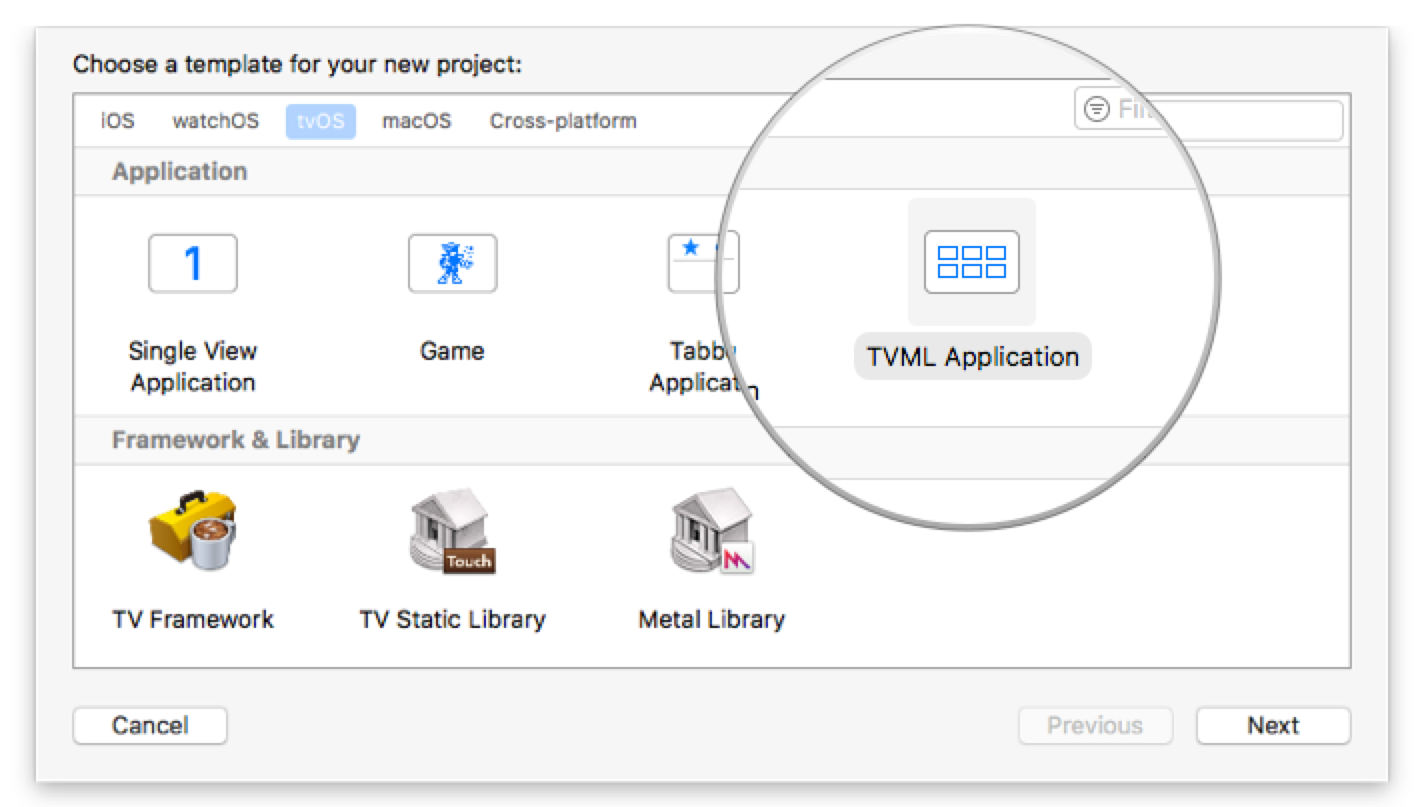
Choose Swift as the language.
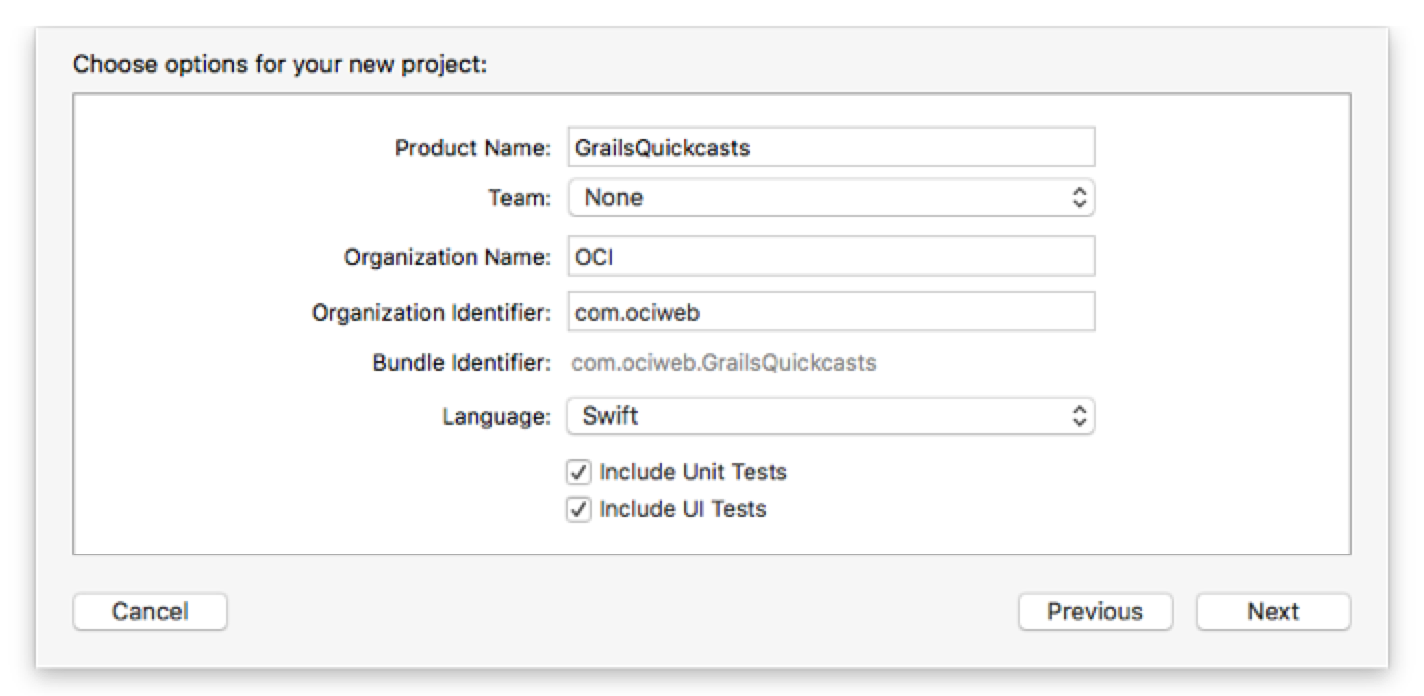
Add a new value App Transport Security Settings (case sensitive), and as its child, add Allow Arbitrary Loads, and set that value to YES.
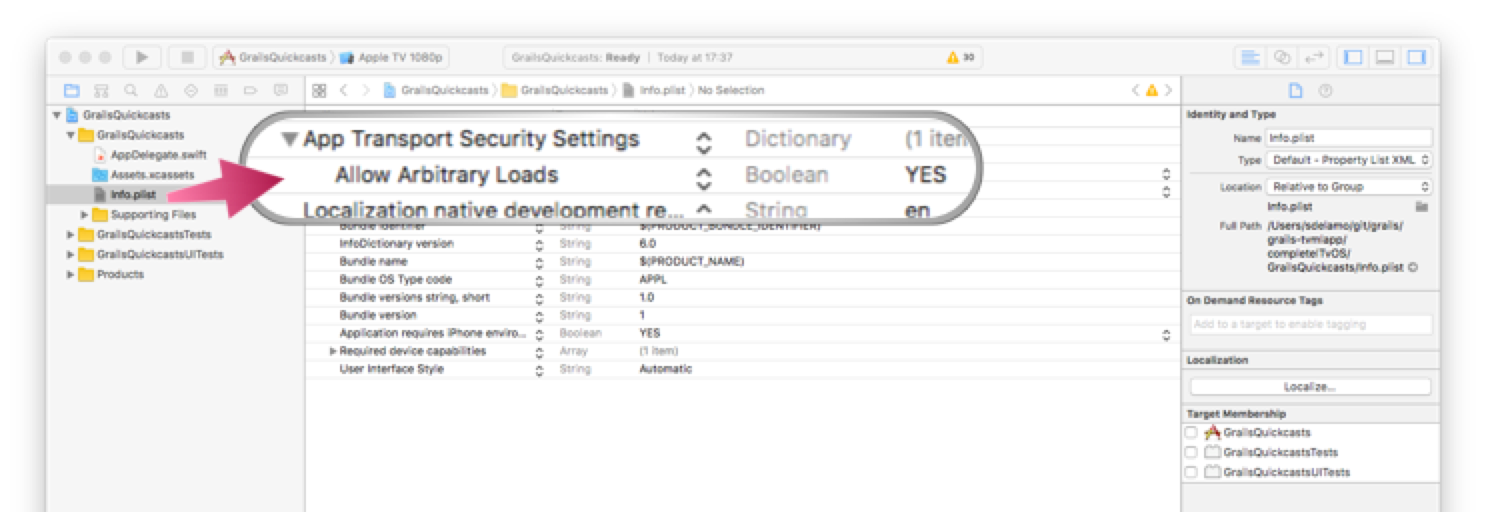
| Adding this key to your Info.plist is necessary because as of iOS 9, your app will prevent linking to non-HTTPS servers to encourage best practices. In this tutorial, you’ll be testing against a local server without HTTPS enabled, so you’ll disable the default behavior. |
Modify AppDelegate.swift and set the static variables tvBaseURL and tvBootURL.
static let tvBaseURL = "http://localhost:8080/"
static let tvBootURL = "\(AppDelegate.tvBaseURL)/assets/application.js"
4 Writing the TVML Grails Application
The initial Grails application, which you can find in the initial folder, was created with the command:
grails create-app --profile rest-api -features=hibernate5,markup-views,asset-pipeline|
Did you know you can download a complete Grails project without installing any additional tools? Go to start.grails.org and use the Grails Application Forge to generate your Grails project. You can choose your project type (Application or Plugin), pick a version of Grails, and choose a Profile - then click "Generate Project" to download a ZIP file. No Grails installation necessary! You can even download your project from the command line using a HTTP tool like |
4.1 TVMLKit JS Utils
TVMLKit JS is a JavaScript API framework specifically designed to work with Apple TV and TVML. TVMLKit JS incorporates the basic functionality found in JavaScript along with specialized APIs designed for Apple TV. Using TVMLKit JS, you are able to load and display TVML templates, play media streams, load customized content, and control the flow of your app. For more information, see TVJS Framework Reference.
Add a JavaScript file to our project. It defines a series of methods nearly identical as those described in the section Playing Media of TVML Programming Guide.
These methods allow to push pages into the navigation stack, fetch documents and play media.
function loadingTemplate() {
var template = '<document><loadingTemplate><activityIndicator><text>Loading</text></activityIndicator></loadingTemplate></document>';
var templateParser = new DOMParser();
var parsedTemplate = templateParser.parseFromString(template, "application/xml");
navigationDocument.pushDocument(parsedTemplate);
}
function getDocument(extension) {
var templateXHR = new XMLHttpRequest();
var url = baseURL + extension;
loadingTemplate();
templateXHR.responseType = "document";
templateXHR.addEventListener("load", function() {pushPage(templateXHR.responseXML);}, false);
templateXHR.open("GET", url, true);
templateXHR.send();
}
function pushPage(document) {
var currentDoc = getActiveDocument();
if (currentDoc.getElementsByTagName("loadingTemplate").item(0) == null) {
navigationDocument.pushDocument(document);
} else {
navigationDocument.replaceDocument(document, currentDoc);
}
}
function playMedia(videourl, mediaType) {
var singleVideo = new MediaItem(mediaType, videourl);
var videoList = new Playlist();
videoList.push(singleVideo);
var myPlayer = new Player();
myPlayer.playlist = videoList;
myPlayer.play();
}4.2 TV Boot Url
This guide uses Asset Pipeline Plugin
The Asset-Pipeline is a plugin used for managing and processing static assets in JVM applications primarily via Gradle (however not mandatory). Asset-Pipeline functions include processing and minification of both CSS and JavaScript files
Create a javascript file which will be the entry to our TVML Grails App:
// This is a manifest file that'll be compiled into application.js.
//
// Any JavaScript file within this directory can be referenced here using a relative path.
//
// You're free to add application-wide JavaScript to this file, but it's generally better
// to create separate JavaScript files as needed.
//
//= require tvmlkit.js
//= require_self
var baseURL;
App.onLaunch = function(options) {
baseURL = options.BASEURL;
var extension = "quickcast";
getDocument(extension);
}Please note, how the line displayed in the next Listing includes the TVMLKit JS file discussed in the previous section.
//= require tvmlkit.jsThe initial TVML document is the XML rendered at http://localhost:8080/quickcast.
The next line designates the initial document:
getDocument(extension);4.3 Domain class
Create a persistent entity to store Quickcasts. Most common way to handle persistence in Grails is the use of Grails Domain Classes:
A domain class fulfills the M in the Model View Controller (MVC) pattern and represents a persistent entity that is mapped onto an underlying database table. In Grails a domain is a class that lives in the grails-app/domain directory.
./grailsw create-domain-class QuickcastThe Quickcast domain class is our data model. We define different properties to store the Quickcast characteristics.
package com.ociweb.quickcasts
class Quickcast {
String title
String subtitle
String description
int durationMinutes
int durationSeconds
int releaseYear
String heroImg
String videoUrl
static hasMany = [authors: String]
static constraints = {
description nullable: true
}
static mapping = {
description type: 'text'
}
}With a Unit Test, we test the property body is optional.
package com.ociweb.quickcasts
import spock.lang.Specification
import grails.testing.gorm.DomainUnitTest
/**
* See the API for {@link grails.test.mixin.domain.DomainClassUnitTestMixin} for usage instructions
*/
class QuickcastSpec extends Specification implements DomainUnitTest<Quickcast> {
void "test description is optional"() {
expect:
new Quickcast(description: null).validate(['description'])
}
}Create a GORM Data Service:
package com.ociweb.quickcasts
import grails.gorm.services.Service
@Service(Quickcast)
interface QuickcastService {
List<Quickcast> findAll()
Quickcast findById(Long id)
Quickcast save(Quickcast quickcast)
}We then load some test data in BootStrap.groovy.
package com.ociweb.quickcasts
import groovy.transform.CompileStatic
@CompileStatic
class BootStrap {
QuickcastService quickcastService
def init = { servletContext ->
quickcastService.save(new Quickcast(title: 'Interceptors - Grails 3',
subtitle: '#1 - Grails Quickcast from OCI',
durationMinutes: 17,
durationSeconds: 01,
releaseYear: 2016,
// tag::dataServerLink[]
heroImg: 'http://localhost:8888/quickcast_interceptor.png',
// end::dataServerLink[]
videoUrl: 'http://localhost:8888/grails_quickcast_1_interceptors.mp4',
authors: ['Jeff Scott Brown'] as Set<String>,
description: 'This Quickcast assumes only basic familiarity with Groovy (which is pretty darn expressive anyway) and the MVC concept (which you already know). Also serves as an excellent introduction to the interceptor pattern in any language, because Grails\' behind-the-scenes legwork lets you focus on the logic of the pattern.'
))
quickcastService.save(new Quickcast(title: 'JSON Views - Grails 3 ',
subtitle: '#2 - Grails Quickcast from OCI',
videoUrl: 'http://localhost:8888/grails_quickcast_2_jsonviews.mp4',
heroImg: 'http://localhost:8888/quickcast_jsonviews.png',
durationMinutes: 15,
durationSeconds: 40,
releaseYear: 2016,
description: '''
n a delightful and informative 15 minutes, Brown probes JSON views. Beginning with a Grails 3.1.1 application, created with a standard web profile, Brown added a few custom domain classes. The artist class has albums associated with it, and is annotated with grails.rest.Resource.
The ultimate goal is publishing a REST API under /artists for managing instances of the artist class, and to support the JSON and XML formats.
Brown uses music examples, including Space Oddity by David Bowie (RIP), and Close to the Edge by Yes. Sending a request to /artists gives a list of artists all of whom have albums associated with them. While the app is running in development mode, the JSON files can be altered and the effects of those changes can be seen real-time in the application. For example, switching "ArtistName": "Riverside" to "theArtistName": "Riverside".
This Quickcast assumes basic knowledge of Grails, JSON, and REST APIs. Check out Brown’s neat intro to JSON views!
''',
authors: ['Jeff Scott Brown'] as Set<String>))
quickcastService.save(new Quickcast(title: 'Multi-Project Builds - Grails 3',
subtitle: '#3 - Grails Quickcast from OCI',
heroImg: 'http://localhost:8888/quickcast_multiprojectbuilds.png',
videoUrl: 'http://localhost:8888/grails_quickcast_2_jsonviews.mp4',
durationMinutes: 14,
durationSeconds: 28,
releaseYear: 2016,
description: '''
In this Quickcast, Graeme Rocher, Head of Grails Development at OCI, walks you through multi-project builds in Grails. Grails does a few handy things with multi-project builds and plugins, not the least of which being that Grails compiles your plugins first and puts the class and resources of those plugins directly in the classpath. This lets you make changes to your plugins and instantly see those changes in your build.
''',
authors: ['Graeme Rocher'] as Set<String>))
quickcastService.save(new Quickcast(title: 'Angular Scaffolding - Grails 3',
subtitle: '#4 - Grails Quickcast from OCI',
heroImg: 'http://localhost:8888/quickcast_angularscaffolding.png',
videoUrl: 'http://localhost:8888/grails_quickcast_2_jsonviews.mp4',
durationMinutes: 9,
durationSeconds: 27,
releaseYear: 2016,
description: '''
In this Quickcast, OCI Engineer James Kleeh walks you through using the Angular Scaffolding for Grails to build a fully functional web app, using a simple blog format for demonstration. The tutorial explains how to have Grails set up a REST endpoint and all the Angular modules needed to get the web app running.
''',
authors: ['James Kleeh'] as Set<String>))
quickcastService.save(new Quickcast(title: 'Retrieving Runtime Config Values - Grails 3',
subtitle: '#5 - Grails Quickcast from OCI',
heroImg: 'http://localhost:8888/quickcast_retrievingruntimeconfigvalues.png',
videoUrl: 'http://localhost:8888/grails_quickcast_2_jsonviews.mp4',
durationMinutes: 17,
durationSeconds: 51,
releaseYear: 2016,
description: '''
In the fifth Grails QuickCast, Grails co-founder, Jeff Scott Brown, highlights some of the great features of the Grails framework. In less than 18 minutes, Jeff describes several techniques for retrieving configuration values at runtime, and discusses the pros and cons of these different techniques. For this Quickcast, you’ll need no more than a basic understanding of Grails. The Grails Quickcast series is brought to you from OCI and DZone.
Grails leverages the “Convention Over Configuration” design paradigm, which functions to decrease the number of decisions that a developer using the framework is required to make without losing flexibility. This is one of the main reasons why Grails significantly increases developer productivity!
While Grails applications often involve considerably less configuration than similar applications built with other frameworks, some configuration may still be necessary. In this short video, Jeff shares a number of mechanisms that make it easy for Grails developers to define configuration values, and to gain access to those configuration values at runtime.
''',
authors: ['Jeff Scott Brown'] as Set<String>))
quickcastService.save(new Quickcast(title: 'Developing Grails Application with IntelliJ IDEA - Grails 3',
subtitle: '#6 - Grails Quickcast from OCI',
heroImg: 'http://localhost:8888/quickcast_developinggrailsappswithintellij.png',
videoUrl: 'http://localhost:8888/grails_quickcast_2_jsonviews.mp4',
durationMinutes: 22,
durationSeconds: 42,
releaseYear: 2016,
description: '''
In the sixth Grails QuickCast, Grails co-founder, Jeff Scott Brown, introduces several tips and tricks related to building Grails 3 applications in IDEA. The Grails Quickcast series is brought to you from OCI and DZone.
Grails 3 is a high productivity framework for building web applications for the JVM. IntelliJ IDEA is a high productivity Integrated Development Environment (IDE) for building a variety of types of applications. IDEA has always had really great support for building Grails applications and, in particular, has the very best support of any IDE for doing development with Grails 3.
''',
authors: ['Jeff Scott Brown'] as Set<String>))
}
def destroy = {
}
}4.4 Stack Template
We show first an Apple TVML Stack Template with the Grails Quickcasts:
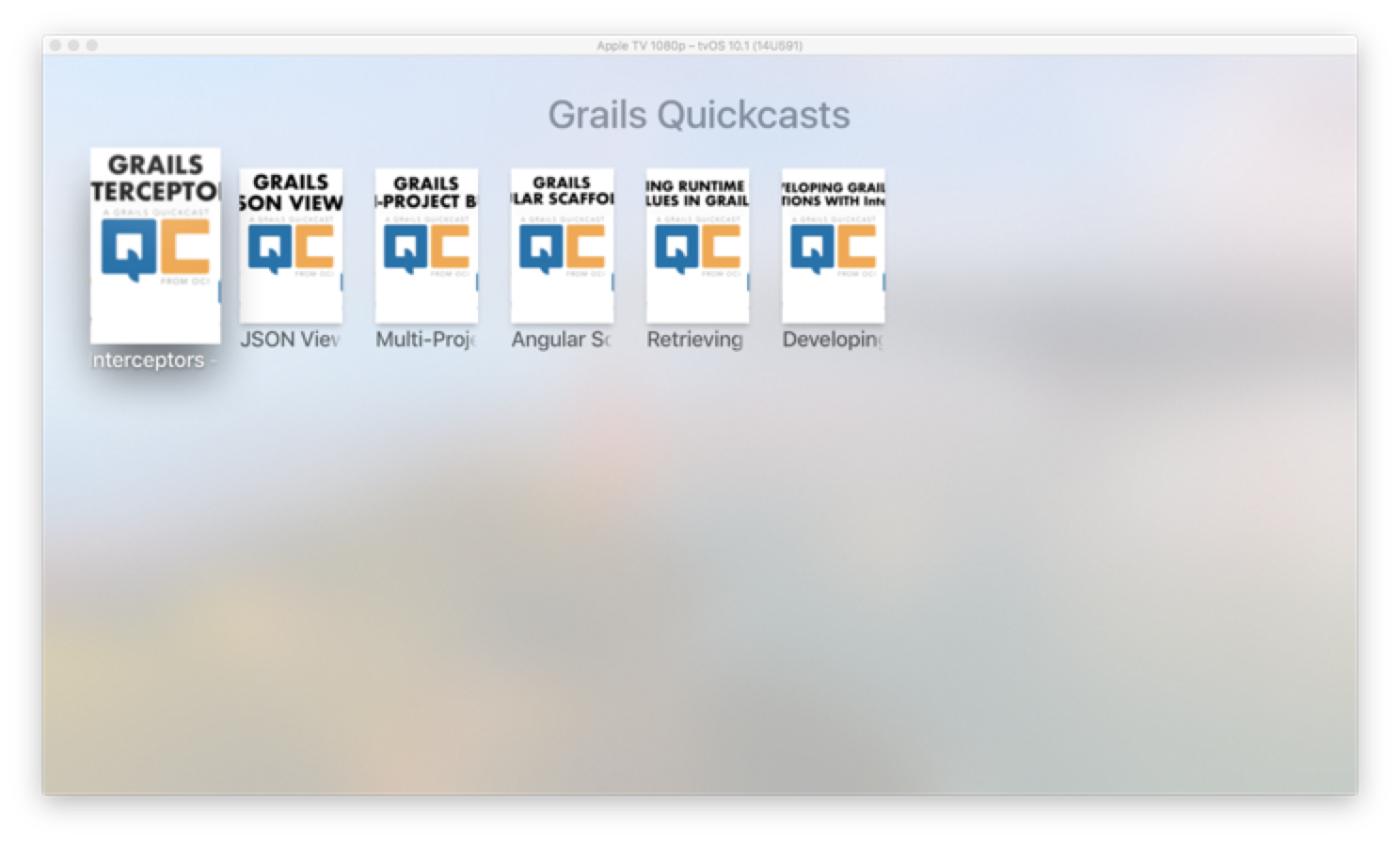
Create a Grails Controller to handle requests
A controller fulfills the C in the Model View Controller (MVC) pattern and is responsible for handling web requests. In Grails a controller is a class with a name that ends in the convention "Controller" and lives in the grails-app/controllers directory.
./grailsw create-controller com.ociweb.quickcasts.QuickcastA request to http://localhost:8080/quickcast executes the index action of QuickcastController
package com.ociweb.quickcasts
import groovy.transform.CompileStatic
@CompileStatic
class QuickcastController {
QuickcastService quickcastService
static responseFormats = ['xml']
RelatedQuickcastsService relatedQuickcastsService
def index() {
[quickcasts: quickcastService.findAll()]
}
def show(Long id) {
Quickcast quickcast = quickcastService.findById(id)
[
quickcast: quickcast,
relatedQuickcasts: relatedQuickcastsService.findAllRelatedQuickcasts(quickcast)
]
}
}The QuickcastController index method renders every Quickcast using the next Markup View
Markup views allow rendering of XML responses using Groovy’s MarkupTemplateEngine
import com.ociweb.quickcasts.Quickcast
model {
Iterable<Quickcast> quickcasts
}
document {
stackTemplate {
banner {
title this.g.message(code: 'quickcasts.title')
}
collectionList {
shelf {
section {
quickcasts.each { quickcast ->
lockup(onselect: "getDocument('quickcast/${quickcast.id}')") {
img(src: quickcast.heroImg, width: 150, height: 226)
title quickcast.title
}
}
}
}
}
}
}Markup Views are written in Groovy, end with the file extension gml and reside in the grails-app/views directory.
Write a functional test to test the XML generated is what we expect.
Add the Micronaut HTTP Client Dependency:
testCompile "io.micronaut:micronaut-http-client"package com.ociweb.quickcasts
import grails.testing.mixin.integration.Integration
import grails.gorm.transactions.*
import grails.testing.spock.OnceBefore
import groovy.xml.XmlUtil
import io.micronaut.http.client.HttpClient
import org.custommonkey.xmlunit.XMLUnit
import spock.lang.Shared
import spock.lang.Specification
import org.springframework.beans.factory.annotation.Value
@Rollback
@Integration
class QuickcastControllerIndexSpec extends Specification {
@Shared HttpClient client
@OnceBefore
void init() {
String baseUrl = "http://localhost:$serverPort"
this.client = HttpClient.create(baseUrl.toURL())
}
def "test stack template is rendered correctly"() {
given:
def expected = '''<document>
<stackTemplate>
<banner>
<title>Grails Quickcasts</title>
</banner>
<collectionList>
<shelf>
<section>
<lockup onselect="getDocument('quickcast/1')">
<img src="http://localhost:8888/quickcast_interceptor.png" width="150" height="226"/>
<title>Interceptors - Grails 3</title>
</lockup>
<lockup onselect="getDocument('quickcast/2')">
<img src="http://localhost:8888/quickcast_jsonviews.png" width="150" height="226"/>
<title>JSON Views - Grails 3</title>
</lockup>
<lockup onselect="getDocument('quickcast/3')">
<img src="http://localhost:8888/quickcast_multiprojectbuilds.png" width="150" height="226"/>
<title>Multi-Project Builds - Grails 3</title>
</lockup>
<lockup onselect="getDocument('quickcast/4')">
<img src="http://localhost:8888/quickcast_angularscaffolding.png" width="150" height="226"/>
<title>Angular Scaffolding - Grails 3</title>
</lockup>
<lockup onselect="getDocument('quickcast/5')">
<img src="http://localhost:8888/quickcast_retrievingruntimeconfigvalues.png" width="150" height="226"/>
<title>Retrieving Runtime Config Values - Grails 3</title>
</lockup>
<lockup onselect="getDocument('quickcast/6')">
<img src="http://localhost:8888/quickcast_developinggrailsappswithintellij.png" width="150" height="226"/>
<title>Developing Grails Application with IntelliJ IDEA - Grails 3</title>
</lockup>
</section>
</shelf>
</collectionList>
</stackTemplate>
</document>
'''
when:
String xml = client.toBlocking().retrieve('/quickcast')
XMLUnit.setIgnoreWhitespace(true)
XMLUnit.setNormalizeWhitespace(true)
then:
XMLUnit.compareXML(XmlUtil.serialize(xml), expected).identical()
}
}To facilitate XML comparison in the tests, we include XMLUnit as a dependency.
testCompile "xmlunit:xmlunit:1.6"4.5 Product Template
When we select the first Quickcast, the document residing in http://localhost:8080/quickast/1 is pushed into the navigation stack
To render a Quickcast, we use the Apple TVML Product Template.
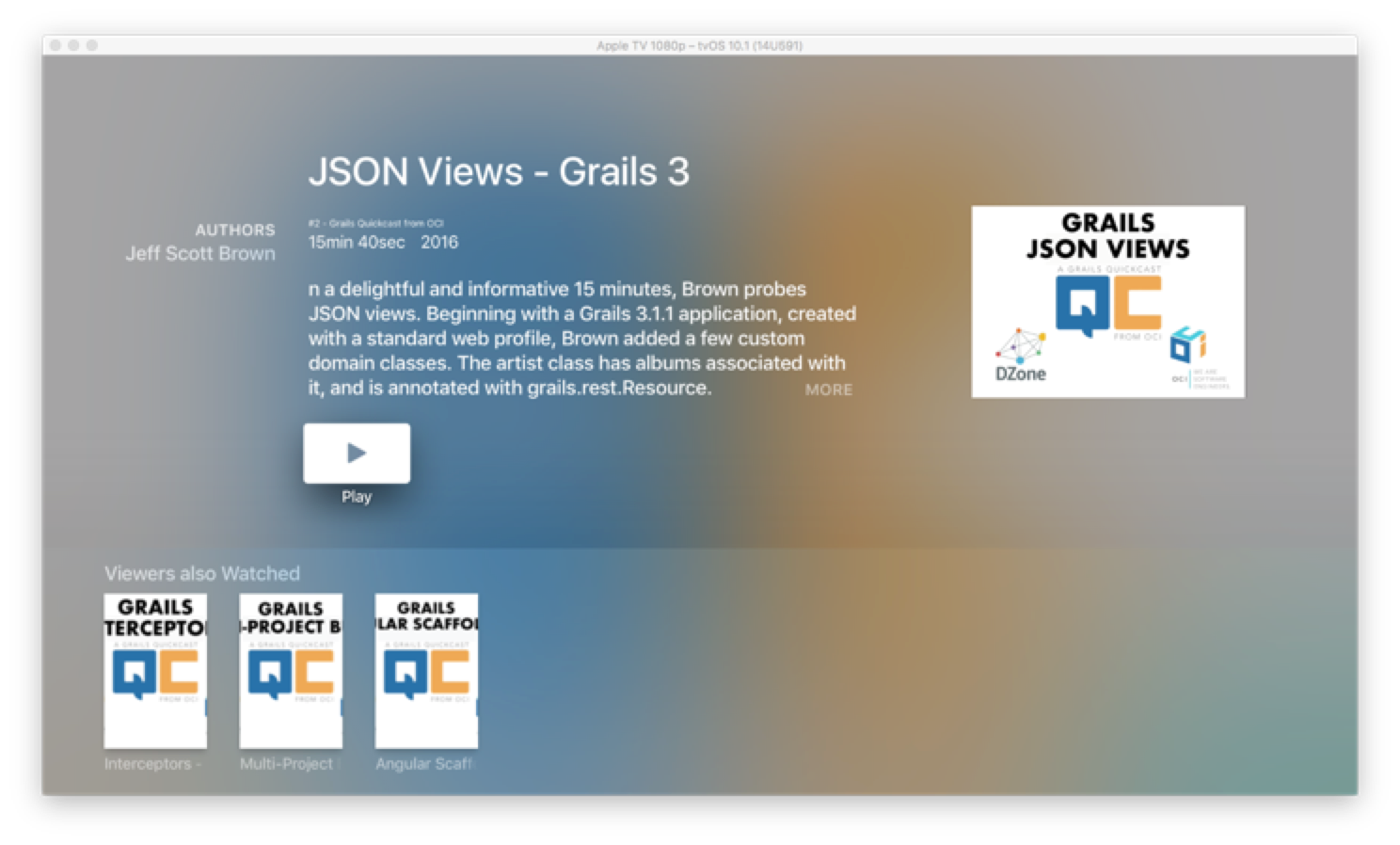
A request to http://localhost:8080/quickcast/1 executes the show action of QuickcastController.
package com.ociweb.quickcasts
import groovy.transform.CompileStatic
@CompileStatic
class QuickcastController {
QuickcastService quickcastService
static responseFormats = ['xml']
RelatedQuickcastsService relatedQuickcastsService
def index() {
[quickcasts: quickcastService.findAll()]
}
def show(Long id) {
Quickcast quickcast = quickcastService.findById(id)
[
quickcast: quickcast,
relatedQuickcasts: relatedQuickcastsService.findAllRelatedQuickcasts(quickcast)
]
}
}The model passed to our view is the requested Quickcast and a series of related videos.
In application.yml, we configure how many related Quickcasts we want to show.
ociweb:
quickcasts:
numberOfRelatedQuickcasts: 3Fetching of related quickcasts is encapsulated in a Service.
package com.ociweb.quickcasts
import grails.config.Config
import grails.core.support.GrailsConfigurationAware
import grails.gorm.transactions.ReadOnly
class RelatedQuickcastsService implements GrailsConfigurationAware {
int numberOfRelatedQuickcasts
@Override
void setConfiguration(Config co) {
numberOfRelatedQuickcasts = co.getRequiredProperty('ociweb.quickcasts.numberOfRelatedQuickcasts', Integer)
}
@ReadOnly
List<Quickcast> findAllRelatedQuickcasts(Quickcast quickcast) {
def criteria = Quickcast.createCriteria()
criteria.list {
ne('id', quickcast?.id)
maxResults(numberOfRelatedQuickcasts)
} as List<Quickcast>
}
}The QuickcastController index method renders a Quickcast using the next Markup View
import com.ociweb.quickcasts.Quickcast
model {
Quickcast quickcast
Iterable<Quickcast> relatedQuickcasts
}
document {
productTemplate {
banner {
infoList {
info {
header {
title this.g.message(code: 'quickcast.authors.header')
}
quickcast.authors.each { author ->
text "$author"
}
}
}
stack {
title quickcast.title
subtitle quickcast.subtitle
row {
text "${quickcast.durationMinutes}min ${quickcast.durationSeconds}sec"
text quickcast.releaseYear
}
description(allowsZooming: "true", moreLabel: "more", "${quickcast.description}")
row {
buttonLockup(onselect: "playMedia('${quickcast.videoUrl}', 'video')") {
badge(src: "resource://button-play")
title "Play"
}
}
}
heroImg(src: quickcast.heroImg)
}
shelf {
header {
title this.g.message(code: 'quickcast.cross.sell.header')
}
section {
relatedQuickcasts.each { relatedQuickcast ->
lockup(onselect: "getDocument('quickcast/${quickcast.id}')") {
img(src: relatedQuickcast.heroImg, width: 150, height: 226)
title relatedQuickcast.title
}
}
}
}
}
}With a functional test, we test the XML rendered is what we expected.
package com.ociweb.quickcasts
import grails.testing.mixin.integration.Integration
import grails.gorm.transactions.*
import grails.testing.spock.OnceBefore
import groovy.xml.XmlUtil
import io.micronaut.http.client.HttpClient
import org.custommonkey.xmlunit.XMLUnit
import spock.lang.Shared
import spock.lang.Specification
@Rollback
@Integration
class QuickcastControllerShowSpec extends Specification {
@Shared HttpClient client
@OnceBefore
void init() {
String baseUrl = "http://localhost:$serverPort"
this.client = HttpClient.create(baseUrl.toURL())
}
def "test product template is rendered correctly"() {
given:
def expected = '''<document>
<productTemplate>
<banner>
<infoList>
<info>
<header>
<title>Authors</title>
</header>
<text>Jeff Scott Brown</text>
</info>
</infoList>
<stack>
<title>Interceptors - Grails 3</title>
<subtitle>#1 - Grails Quickcast from OCI</subtitle>
<row>
<text>17min 1sec</text>
<text>2016</text>
</row>
<description allowsZooming="true" moreLabel="more">This Quickcast assumes only basic familiarity with Groovy (which is pretty darn expressive anyway) and the MVC concept (which you already know). Also serves as an excellent introduction to the interceptor pattern in any language, because Grails' behind-the-scenes legwork lets you focus on the logic of the pattern.</description>
<row>
<buttonLockup onselect="playMedia('http://localhost:8888/grails_quickcast_1_interceptors.mp4', 'video')">
<badge src="resource://button-play"/>
<title>Play</title>
</buttonLockup>
</row>
</stack>
<heroImg src="http://localhost:8888/quickcast_interceptor.png"/>
</banner>
<shelf>
<header>
<title>Viewers also Watched</title>
</header>
<section>
<lockup onselect="getDocument('quickcast/1')">
<img src="http://localhost:8888/quickcast_jsonviews.png" width="150" height="226"/>
<title>JSON Views - Grails 3</title>
</lockup>
<lockup onselect="getDocument('quickcast/1')">
<img src="http://localhost:8888/quickcast_multiprojectbuilds.png" width="150" height="226"/>
<title>Multi-Project Builds - Grails 3</title>
</lockup>
<lockup onselect="getDocument('quickcast/1')">
<img src="http://localhost:8888/quickcast_angularscaffolding.png" width="150" height="226"/>
<title>Angular Scaffolding - Grails 3</title>
</lockup>
</section>
</shelf>
</productTemplate>
</document>
'''
when:
String xml = client.toBlocking().retrieve('/quickcast/1')
XMLUnit.setIgnoreWhitespace(true)
XMLUnit.setNormalizeWhitespace(true)
then:
XMLUnit.compareXML(XmlUtil.serialize(xml), expected).identical()
}
}4.6 Internationalization
Internationalization is a first-class citizen in Grails.
Grails supports Internationalization (i18n) out of the box by leveraging the underlying Spring MVC internationalization support. With Grails you are able to customize the text that appears in a view based on the user’s Locale.
To render such a snippet:
given:
def expected = '''<document>We use this code:
header {
title this.g.message(code: 'quickcast.authors.header')
}Define message codes and default values in messages.properties
resouce.button.play=Play
quickcast.authors.header=Authors
quickcast.cross.sell.header=Viewers also Watched
quickcasts.title=Grails QuickcastsIncluding a Spanish localization is easy. Include the localized message codes in
messages_es.properties.
resouce.button.play=Reproducir
quickcast.authors.header=Autores
quickcast.cross.sell.header=Otros usuarios también vieron
quickcasts.title=Grails Quickcasts5 Running the Application
To run the Grails application use the ./gradlew bootRun command which will start the application on port 8080.
Run the Xcode project and your Apple TvOS app will connect to your Grails Backend.
